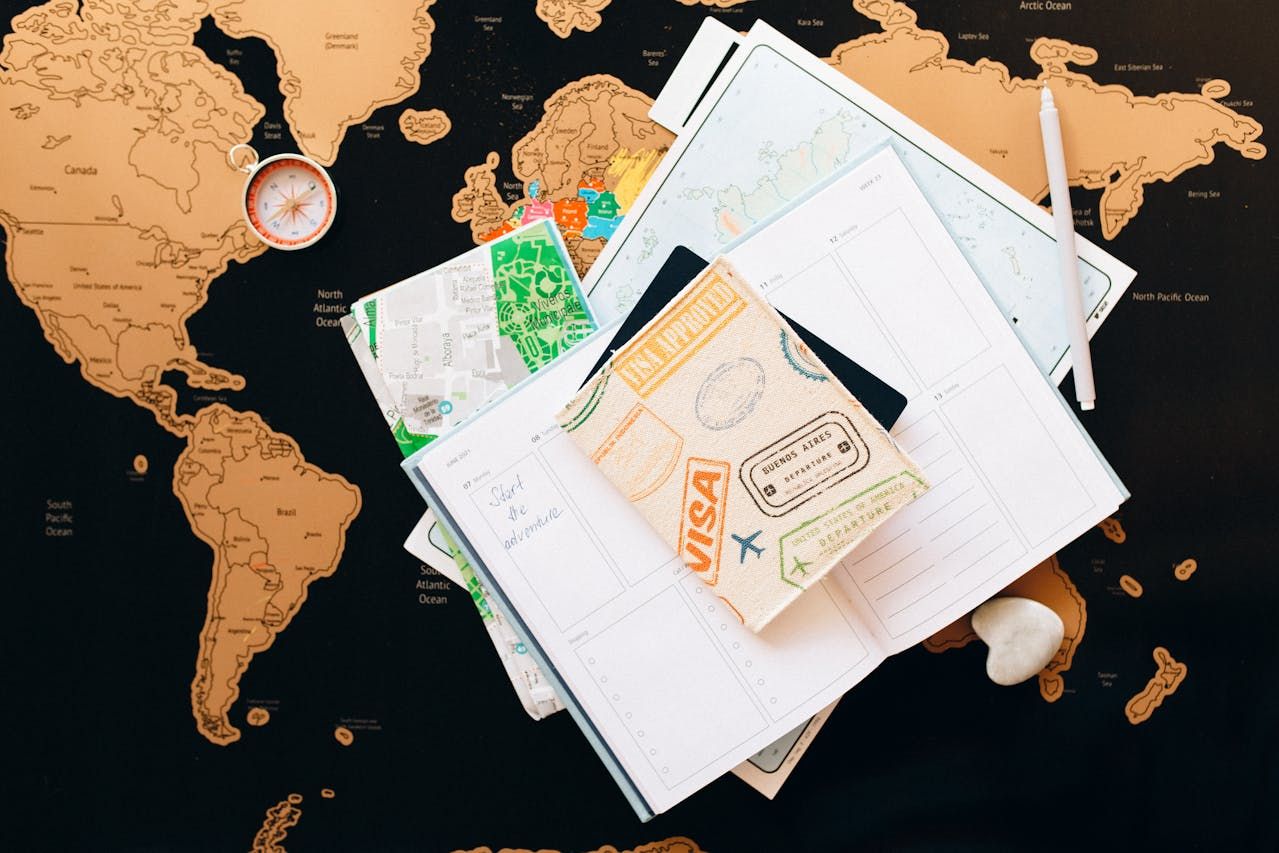In 2025, having a strong passport matters more than ever when deciding where to live or work. It doesn’t just make your trip easier, it can open doors to new job opportunities, education, and simpler travel overall. After the pandemic, new visa policies and the rise of remote work programs highlighted the importance of knowing how much freedom a passport can give you.
In this article, we will explore the top 10 passports in 2025 and explain why they matter so you can understand how to take full advantage of your passport’s power.

The 2025 Passport Power Rankings
Let’s start by looking at the 2025 Passport Power Rankings, published by the Henley Passport Index. This global ranking, based on data from the International Air Transport Association (IATA), measures how many destinations a passport holder can access without needing a visa in advance. It includes visa-free, visa-on-arrival, and e-visa entries (excluding those that require prior approval), and is updated regularly to reflect shifting international policies.
Here are the top 10 passports for 2025 and how many destinations each allows access to:
1st Place
- Singapore: 195 destinations
2nd Place
- Japan: 193 destinations
3rd Place
- France: 192 destinations
- Germany: 192 destinations
- Italy: 192 destinations
- South Korea: 192 destinations
- Spain: 192 destinations
4th Place
- Austria: 191 destinations
- Denmark: 191 destinations
- Ireland: 191 destinations
- Luxembourg: 191 destinations
- Netherlands: 191 destinations
- Norway: 191 destinations
- Sweden: 191 destinations
5th Place
- Belgium: 190 destinations
- New Zealand: 190 destinations
- Portugal: 190 destinations
- Switzerland: 190 destinations
- United Kingdom: 190 destinations
6th Place
- Australia: 189 destinations
- Czechia: 189 destinations
- Greece: 189 destinations
- Malta: 189 destinations
- Poland: 189 destinations
7th Place
- Canada: 188 destinations
- Hungary: 188 destinations
- United States: 188 destinations
8th Place
- Estonia: 187 destinations
- Lithuania: 187 destinations
9th Place
- Latvia: 186 destinations
- Slovakia: 186 destinations
- Slovenia: 186 destinations
10th Place
- Iceland: 185 destinations
- United Arab Emirates: 185 destinations
These rankings are based on data from the International Air Transport Association on 227 travel spots worldwide. The index counts destinations accessible visa-free, with a visa-on-arrival, or with an e-visa (if not requiring prior approval). It’s updated regularly to keep up with changing global travel rules and diplomatic ties.
According to the Henley Passport Index, Singapore tops the list with visa-free or visa-on-arrival access to an impressive 195 destinations. Japan follows closely with 193, while several European countries like France, Germany, Italy, South Korea, Spain, and Austria all share spots with access to around 191 countries. The United Arab Emirates made a big jump to 10th place with access to 185 destinations, joining other strong passports like Denmark, Ireland, the UK, Canada, and the US.
This year, Singapore remained firmly in first place, while Japan rose to second. Japan’s improvement is likely due to regaining broader access to more destinations after the pandemic, with changes in certain bilateral visa policies (such as with China) playing only a partial role.
The UAE’s rise is remarkable, gaining lots of new access points over recent years thanks to strong diplomacy. Meanwhile, the US slipped from second to seventh, and the UK, which used to rank higher in previous years, now sits in 5th place. India’s position also fell, partly due to ongoing travel restrictions.
These changes show how travel freedom is constantly changing, influenced by recovery from the pandemic, new visa policies, and changing international relationships. It’s interesting to see some countries improving by building global connections, while traditional leaders face more competition.
Passport Power Isn’t Everything
Having a strong passport that lets you travel without a visa doesn’t guarantee you’ll get into every country. Officials have the power to refuse entry if they think you’re not following the rules or if something feels off. They might ask lots of questions, put you through tough checks, or even deny entry. Many countries allow tourists in without visas, but don’t allow any kind of work during that time. If you mention work plans or don’t clearly explain why you’re visiting, you might be turned away or held up.
There are plenty of real examples where passport strength wasn’t the whole story. Fabian Schmidt, a German permanent resident of the U.S., was held at Boston Logan Airport and sent to a detention center in Rhode Island, where he faced tough questioning. Officials reportedly detained him due to alleged inconsistencies in his travel documents and concerns over his immigration status, although no formal charges were brought.
Jessica Brösche, a German tattoo artist, was detained for more than six weeks when she decided to travel to the US from Tijuana with an American friend, even though she had a valid tourist visa. She was even put in solitary confinement for part of that time.
On the flip side, travelers with so-called “weaker” passports sometimes manage to get into strict countries by carefully preparing their paperwork, showing clear reasons for their visit, and following all the rules. Thorough preparation can make a big difference.
What to Do If Your Passport Ranks Lower
If your passport isn’t the strongest, there are smart ways to live and work abroad without being held back by visa restrictions. Many countries now offer digital nomad or remote work visas that let you stay and work legally for months or even years. Instead of relying on your passport’s rank, these visas focus on proving you have a remote job, steady income, and health insurance.
Another great way to improve your travel freedom is through dual citizenship or residency. Having a second passport can open doors to many more countries without the hassle of visas. Some people get citizenship through their ancestry in countries like Italy or Ireland, while others invest in programs offered by places like Malta or St. Kitts and Nevis to get a new passport. These options take some planning and investment, but can really expand where you can go.
Most Overrated and Underrated Passports
Not every powerful passport shines in global rankings. Some passports might fly under the radar but offer great travel perks within important regions.
Take Chile’s passport, for example. It might not be among the world’s highest-ranked, but it’s strong within Latin America. Chilean citizens can travel visa-free across most South American countries and many other places. This regional strength makes it easier to explore and do business in Latin America, even if Chile’s passport isn’t as well-known globally.
Some passports, like Japan’s and Singapore’s, look impressive because they allow visa-free travel to over 190 countries. But that doesn’t always mean you can stay long or visit as often as you want. Many countries limit visa-free visits to between 30 and 90 days. For example, Japanese passport holders can enter many countries easily, but they often face short stays and restrictions on how many times they can visit within a year.
Singapore’s passport is similar. It offers wide access, but travelers sometimes have to leave and re-enter a country to reset their visa-free stay. Some countries even cap the total number of visa-free visits you can make in a year. So, while these passports look strong on paper, if you want to stay longer, work, or travel frequently, you usually need extra visas or permits.
In short, visa-free access is an important part of passport strength, but it doesn’t guarantee the freedom to stay long or visit repeatedly. Travelers still need to follow local rules and apply for the right visas if they want to spend more time or come back often.

Photo by Inkredo Designer on Unsplash
Make the Most of Your Passport in 2025
When planning your trip, think about what your passport can do. Some passports offer access to many countries without a visa, while others may need more planning. Tools like the Henley Passport Index help you see where you can go visa-free. If your passport ranks high, you can build trips across continents with fewer entry requirements. If it ranks lower, focus on regions like Southeast Asia, South America, or the Schengen Area, where getting in is easier.
Traveling in 2025 can be easier, smarter, and more enjoyable with the right tools. Staying connected is one of the first things to consider, and eSIM technology makes that simple. Instead of swapping physical SIM cards, you can activate mobile data plans through an app or QR code. If you’re interested in trying an easy-to-use eSIM, Yoho Mobile offers a free trial that lets you get online quickly without a credit card or contract.
With a little planning and the right digital tools, your passport can take you further in 2025.
FAQs About Passport Rankings
Can I get a passport from another country legally?
Yes, you can get a passport from another country legally in several ways:
- By Descent: If your parents or grandparents are from that country, you might qualify by proving your family ties.
- By Marriage: Marrying someone from that country can help you become a citizen, usually after living there for some time and providing paperwork.
- By Naturalization: If you live in a country long enough and meet certain requirements (like language skills), you can apply for citizenship.
- By Investment: Some countries let you become a citizen faster if you invest money there.
Which countries let you travel the most without flying?
If you want to travel without flying, many countries in Europe, Latin America, Africa, and Asia let you move between neighbors by land or sea.
- In Europe, countries in the Balkans like Albania, Serbia, and Ukraine are connected by road and rail, so you don’t need to fly.
- In Latin America, countries like Argentina, Brazil, and Peru share borders and offer visa-free travel, allowing overland trips.
- In Africa, places like Morocco, South Africa, and Tunisia allow visa-free or easy visa access, with land or ferry travel options.
What about refugees or people without a nationality?
Refugees and stateless people often don’t have passports but can get special travel documents under international refugee agreements. These help them travel internationally, access basic services, and protect them from being forced to return home. But travel can still be limited due to legal issues and some countries’ rules. Refugees may need to apply for permanent residency or citizenship after some time. Each country has different programs and policies for refugees.
How does having a passport affect banking, taxes, and jobs?
A passport is the main ID needed to open bank accounts in other countries. Banks check your passport to confirm your identity and citizenship, which helps prevent illegal money activities. Besides a passport, you usually need proof of address and where your money comes from. Having a passport can also affect your work and tax responsibilities since it helps prove your citizenship and residency, which influences your eligibility to work and pay taxes in different countries.
What are some of the most beautiful passports?
Some of the most attractive passports in 2025 include:
- Switzerland: Shows detailed maps of its regions with special UV security features.
- Japan: Features traditional Japanese art like “The Great Wave” and cherry blossom patterns.
- Norway: Has pictures of landscapes and historic places with artistic designs.
- New Zealand: Black cover with Maori art and navigation themes that show more under UV light.
- Canada: Shows seasonal nature scenes with detailed UV artwork.
- Finland: Inspired by its archipelago, and includes an animated seal effect.
- Bahrain: Combines history and stars with UV features.
- Belgium: Includes famous comic characters like Tintin and Smurfs as security elements.

